 |
 |
 |
| |
Reverset (d4FC), new NRTI: phase IIb data
|
| |
| |
Reported by Jules Levin
So, I am staying in Ipanemia at a hotel on the beach. Next door is Copacabana. Both are on the beach and a 1 hour bus ride from the conference, everyone is complaining about this bus ride, back & forth everyday from hotels. I jog on the path right by the beach & this is great. Went to two dinners past two nights, food & restaurants were great. Attendees are having fun & so am I. Rio Schmio may have fun things to offer: big ststue of Christ, Sugar loaf mountain, old downtown Rio. I expect to do sightseeing after conference & return Friday, I report back if it was fun. The data on Reverset & TMC114 are two oral Late Breakers of most interest, but entry inhibitors are getting interest here and a few other new drugs I'll report on. Yesterday's report on TMC114/r should be posted to NATAP website today.
"Antiretroviral Activity and Tolerability of Reverset (D Antiretroviral Activity and Tolerability of Reverset (D-d4FC), a New d4FC),
--a New Fluorocytidine Nucleoside Analog, When Used in Combination Therapy in py in Treatment Treatment-Experienced Patients:
--Results of Phase IIb Study RVT Experienced Patients: Results of Phase IIb Study RVT-203 203"
C. Cohen,1 C. Katlama,2 R. Murphy,3 J. Gathe,4 C. Brinson,5 G. Richmond,6 P.-M. Girard,7 J. Fessel,8 A. Liappis,9
E. Puglia,10 B. Rodwick,11 J. Nadler,12 W. O'Brien,13 K. Arasteh,14 M. Otto,15 S. Erickson-Viitanen,16 and R. Levy16
1Community Research Initiative of New England, Boston, USA; 2Hôpital de la Pitié, Paris, France; 3Northwestern University, Chicago, USA; 4Fannin Street, Houston, USA;
5Central Texas Clinical Research, Austin, USA; 6315 SE 14th Street, Fort Lauderdale, USA; 7Hôpital St. Antione, Paris, France; 8Kaiser Permanente, San Francisco, USA;
9George Washington University Medical Center, Washington, DC, USA; 10Research Center of Florida, Inc., Miami, USA; 11Clinical Research of West Florida, Clearwater, USA;
12Hillsborough County Health Department, Tampa, USA; 13University of Texas Medical Branch, Galveston, USA; 14EPIMED, Berlin, Germany; 15Pharmasset, Inc. Tucker, USA; 16Incyte Corp., Wilmington, USA
ABSTRACT
Objectives: Evaluate efficacy and tolerability of once daily doses of 50, 100 or 200 mg Reverset (RVT), a cytidine analog NRTI, in ARV-experienced patients.
Methods: Phase IIb, randomized, blinded, multinational, placebo-controlled 3 stage study consisting of: 2 wk add-on phase (RVT or placebo); 14-wk optimized treatment phase; and 8-wk safety phase (placebo pts allowed to cross over) in
treatment-experienced patients (pts.).
Results: 199 pts enrolled at 25 sites; currently, 120 completed >16 wks of therapy. Mean baseline VL = 4.5 log10, presence of M184V: 60%, M41L: 60%, 4-6 TAMs: 50%, K65R: 6%.
After 2 wks, mean VL changed by +0.007, -0.5, -0.3, and -0.7 log10 for placebo, 50, 100, and 200 mg groups respectively.
Pts on 200 mg with 0-3 TAMs had 2-wk VL drop of 0.8 log10, with 4-6 TAMs a 0.6 log10 drop.
Pts with M41L, M41L+L210W or w/o M41L showed similar VL decreases (0.7 log10).
Pts with K65R or M184V + TAMs had more variable responses (mean 0.4 log10 drop); >20% pts had > 1 log10 drop.
33% pts didn't optimize at wk 2. Of these, current data shows stable VL decrease of about 0.6 log10 at wk 16 on 200 mg RVT.
AEs generally mild, included headache, fatigue and GI disorders.
In 35 subjects taking RVT with ddI, 12 (34%) had grade 4 hyperlipasemia, usually occurring after >12 wks of treatment. Among pts not on ddI, asymptomatic grade 4 lipase seen in 5.4% of pts on 200 mg RVT vs. 3.1% on placebo. Pancreatitis seen in 3 pts on RVT+ddI+TDF: 1 pt on ddI 250mg/TDF 450mg, 1 pt on ddI 400mg/TDF 300mg; all resolved off drugs.
NOTE FROM JULES: In speaking with study authors the hyperlipasemia so far observed was explained by reasons other than associated with Reverset such as alcohol use by one of the patients with hyperlipasemia. Look at the data below & you will see a very small number of patients were affected. Still, this potential toxicity should be followed closely.
Conclusions: RVT 200 mg is active in ARV-experienced pts and generally well tolerated. Because of the risk of elevated lipase and pancreatitis, RVT should not be used with ddI. Data support continued development of RVT.
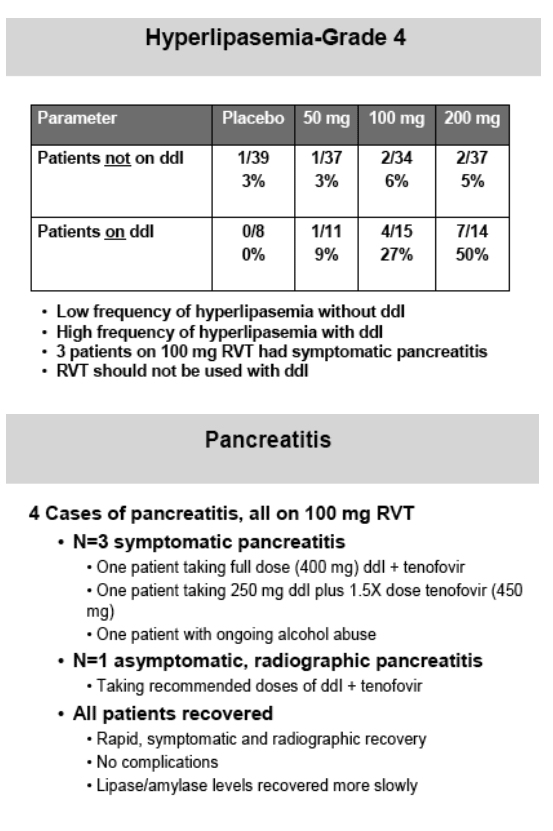
CONCLUSIONS (followed by pictures of study results)
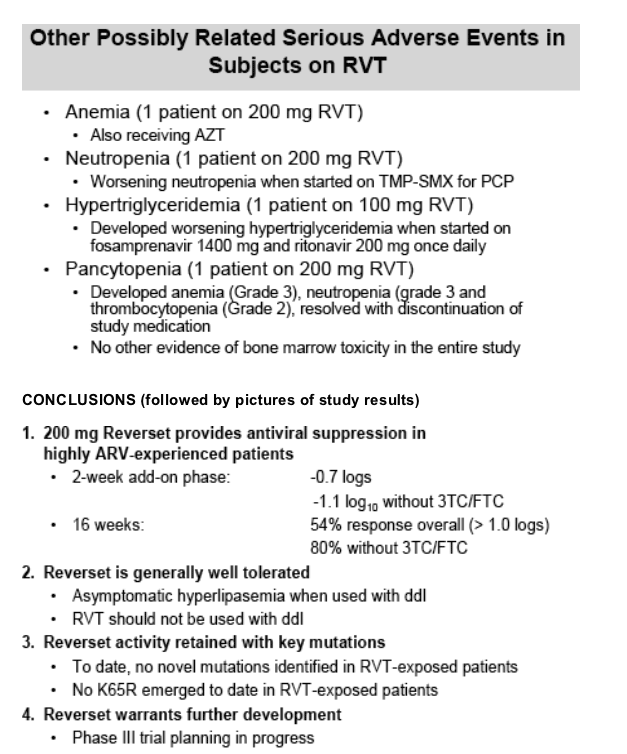
BACKGROUND INFORMATION
- Preclinical studies demonstrated
- Active with viral mutants resistant to 3TC, TDF, AZT, other NRTIs, NNRTIs, and PIs
- Long intracellular half-life (17 hours)
- No mitochondrial toxicity or lactic acid increase (in vitro)
- 10-day add-on dosing demonstrated
- VL decrease of 0.8 logs with 200 mg qd dosing in therapy-experienced patients
- VL decrease of 1.8 logs with 200 mg qd dosing in therapy-naïve patients
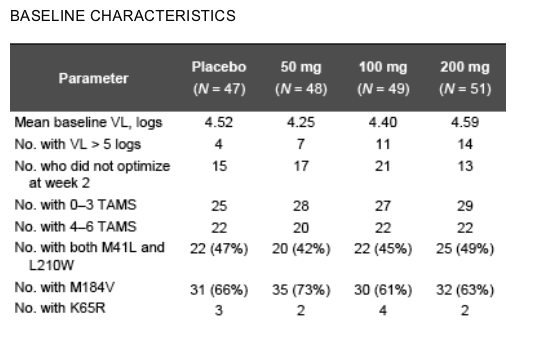
RVT-203 Study Design
_ Randomized, placebo-controlled, double-blind study in 3 phases:
1. 2-week add-on
2. then 14-week treatment with optimized background regimen
3. followed by 8-week placebo cross-over
2 week add-on was for:
- Determine short-term potency/select dose
- Assess impact of resistance mutations
- Assess impact of concurrent ARVs
- Determine durability of response/select dose
- Assess development of resistance mutations
- Assess impact of optimized background
- Identify populations which will benefit most
- Assess longer term safety and tolerability
Demographics and Endpoints
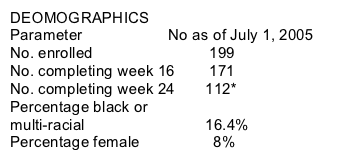
Endpoints
- Primary variables
--Mean change in viral load to week 2 and week 16
--Adverse events (AEs)
- Secondary variables include
--Proportions > 1 log decline
--Patients who did/did not optimize at week 2
*Study is still ongoing
RESULTS
2-Week Add-On Phase
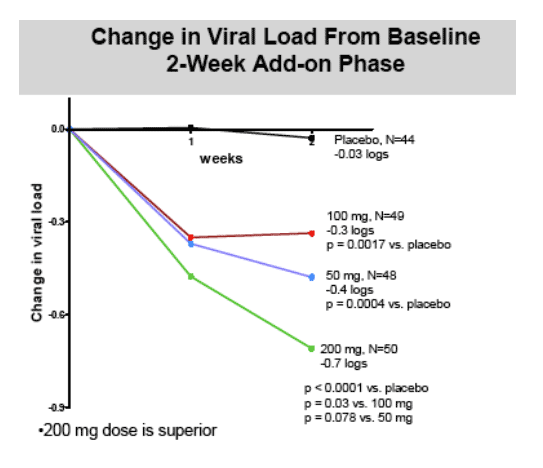
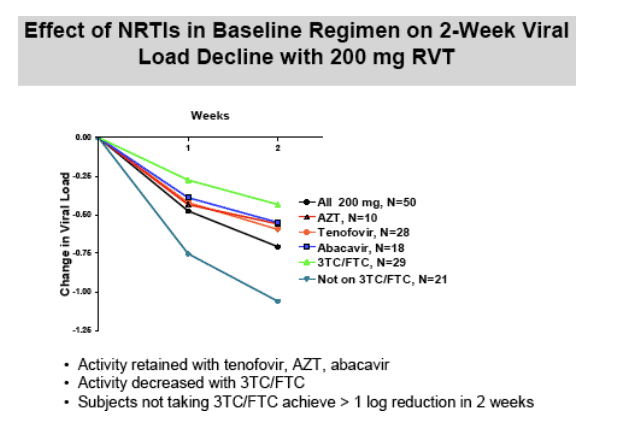
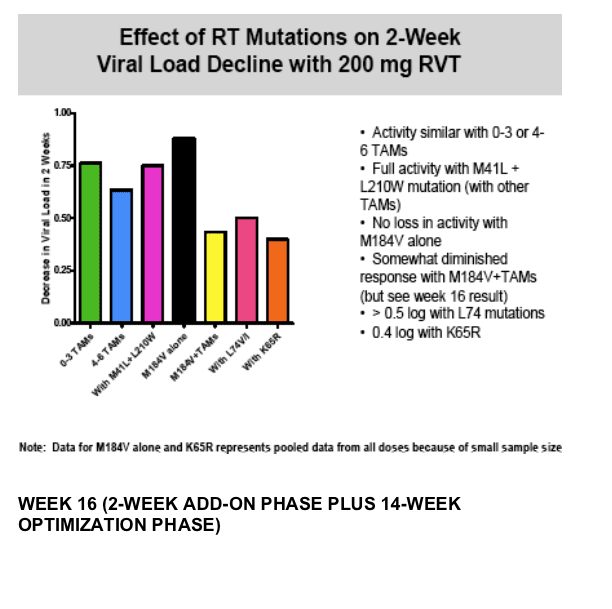
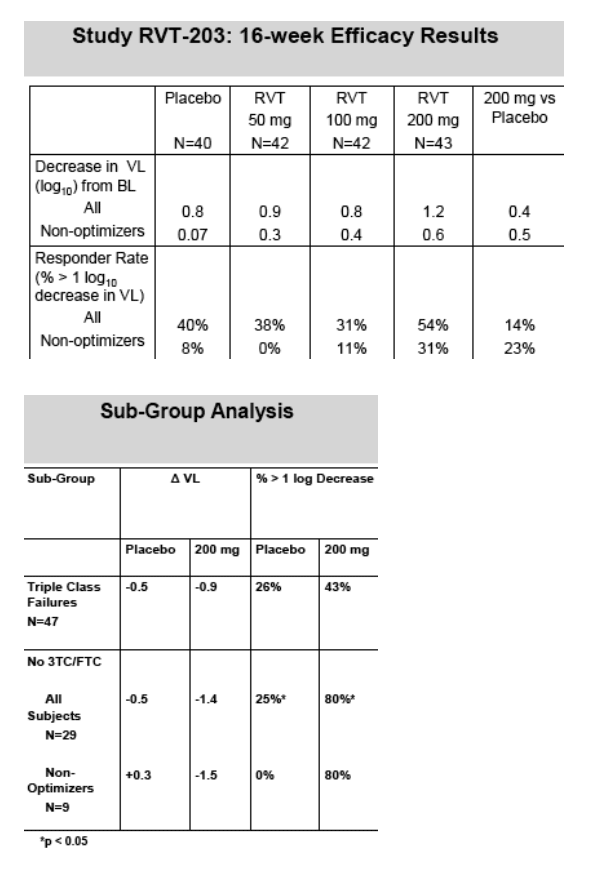
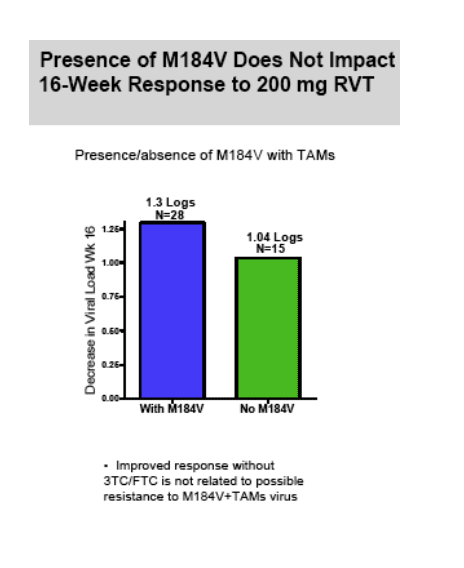
WEEK 16 (2-WEEK ADD-ON PHASE PLUS 14-WEEK OPTIMIZATION PHASE)
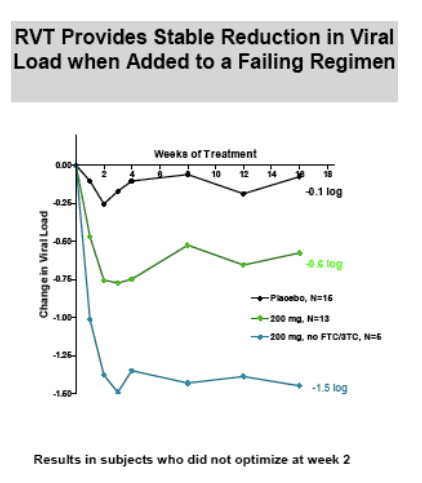
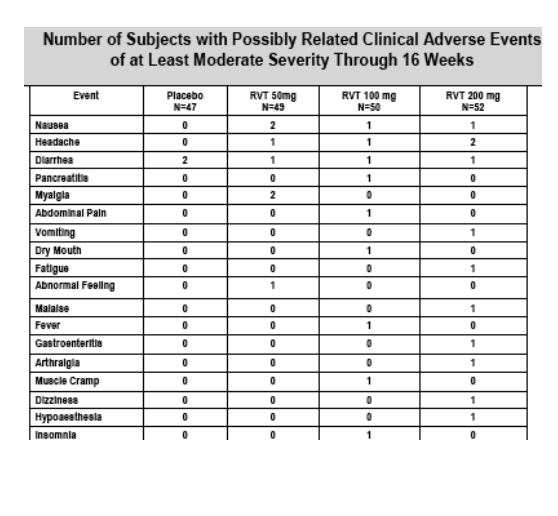
|
|
| |
|
 |
 |
|
|